Table of Content
1. Indian Challenger Vs. Harley Davidson Road Glide
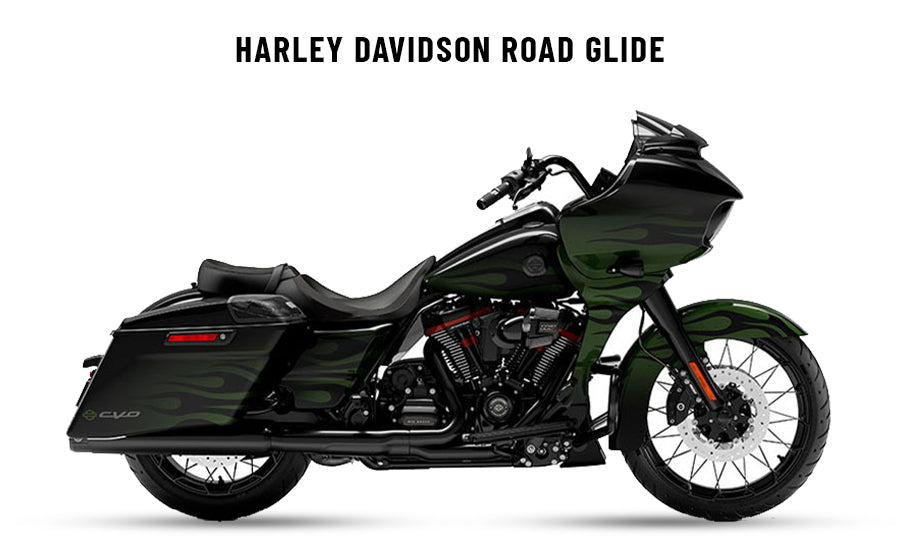
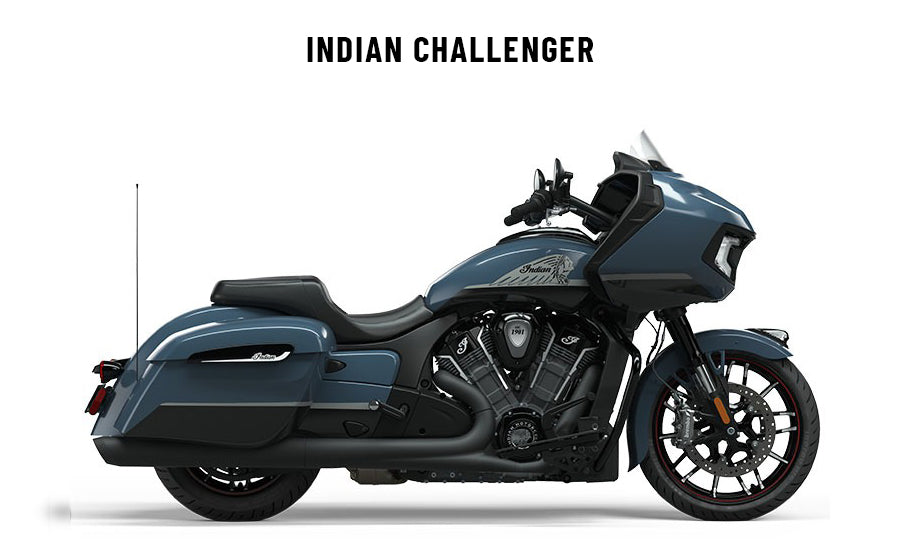
If you are a fan of bulky motorcycles with stock saddlebags, fairings, and an infotainment system that ensure a fun touring experience, then the Indian Challenger and the Harley Davidson Road Glide are the best options. Both motorcycles come with modern ride-assist features and comfortable ergonomics. The Indian Challenger has a compact design with more blacked-out parts that give it a modern look. It comes with a slightly larger engine than the Harley Road Glide, capable of producing more horsepower and torque.
The Indian Challenger is also bigger than the Harley Road Glide, with a height of 53 inches, a wheelbase of 65.7 inches, and a taller seat height of 26.5 inches. However, due to its light aluminum frame and parts, it weighs 24 lbs less than the Harley Road Glide. Meanwhile, the Harley Road Glide has a low seat height of 25.9 inches and a wet weight of 855 lbs due to being built with metallic parts. It is also a comfortable touring bike due to its relaxed riding position. This article provides a detailed comparison between the Indian Challenger and the Harley Davidson Road Glide.
2. Detailed Specs Comparison: Indian Challenger Vs. Harley Davidson Road Glide
| 2022 Indian Challenger | 2022 Harley Davidson Road Glide | |
|---|---|---|
| Identification | ||
| Indian | Maker | Harley Davidson |
| Challenger | Model | Road Glide |
| 2022 | Year Model | 2022 |
| Touring Bike | Motorcycle Type | Touring Bike |
| $24,499 | Base Price | $21,430 |
| Engine and Performance | ||
|---|---|---|
| 108 cu in (1,768 cc) | Displacement | 107 cu in (1,753 cc) |
| PowerPlus 60° V-twin | Engine Design and Type | Milwaukee-Eight® 107 V-Twin |
| Liquid-Cooled | Cooling System | Air-Cooled |
| Two | No. of Cylinders | Two |
| Four | Valves Per Cylinder | Four |
| 122 hp at 5,500 rpm | Horsepower | 93 hp at 5,020 rpm |
| 173.54 Nm at 3,800 rpm | Torque | 150.5 Nm at 3,250 rpm |
| 3.8 in | Stroke | 4.38 in |
| 4.25 in | Bore | 3.94 in |
| Closed loop fuel Injection / 52 mm dual bore | Fuel Injection System | Electronic Sequential Port Fuel Injection (ESPFI) |
| 11:1 | Compression Ratio | 10:1 |
| Six-Speed | Transmission | Six-Speed |
| Belt | Final Drive | Belt |
| Wet, Multi-Plate with Assist function | Clutch | Mechanically Actuated, 10 Plate Wet with Assist and Slipper Clutch |
| 47 mpg | Fuel Economy | 43 mpg |
| Chrome Dual Mufflers | Muffler | Dual Tapered Mufflers |
| Split Dual Exhaust with Resonator | Exhaust | Two-Into-One-Into-Two Chrome Exhaust |
| Standard | ABS | Optional ($819) |
| Aluminum | Frame | Mild Steel Tubular |
| Electric | Starter | Electric |
| Chassis-Mounted | Fairing | Frame-Mounted |
| Shark-Nose Fairing | Fairing Style | Shark-Nose Fairing |
| Dimensions and Weight | ||
|---|---|---|
| 5.9 in | Trail | 6.8 in |
| 25° | Rake | 26° |
| 6 gal | Fuel Tank Capacity | 6 gal |
| 5.4 in | Ground Clearance | 5.5 in |
| 39 in | Width | 38.6 in |
| 53 in | Height | 51.6 in |
| 98.5 in | Length | 95.7 in |
| 26.5 in | Seat Height | 25.9 in |
| 65.7 in | Wheelbase | 64 in |
| 831 lbs | Wet Weight | 855 lbs |
| 796 lbs | Dry Weight | 820 lbs |
| 31° | Lean Angle (Right) | 31° |
| 31° | Lean Angle (Left) | 29° |
| 2.4 cu ft | Luggage Capacity | 2.3 cu ft |
3. Design: Indian Challenger Vs. Harley Davidson Road Glide
3.1 Design: Indian Challenger
The Indian Challenger is a bagger-style touring bike with blacked-out and chrome parts that give it a modern look. The chrome parts include the cylinder heads, air filter, gearbox, and split dual exhaust pipes. It comes with low-mounted, slightly swept-back handlebars with blacked-out side mirrors. The Indian Challenger is fitted with a narrow, chopped front fender and a large rear fender with a small LED tail light, turn signals, and a license plate holder. It also comes with a shark-nose fairing with a small windscreen, a seven-inch touchscreen display, dual analog meters, and an audio system.
The Indian Challenger is fitted with a single-piece step-up seat, stock hard saddlebags, and forward-mounted floorboards. A blacked-out radiator is also installed behind the front wheel to maintain the engine’s temperature. The Indian Challenger comes with Metzeler Cruisetec tires wrapped around sport cast black wheels.
3.2 Design: Harley Davidson Road Glide
The Harley Davidson Road Glide is a classic touring motorbike available in three single-tone color schemes and chrome finishing. The chrome parts include the two-into-one-into-two exhaust with dual tapered mufflers, handlebars, front forks, cylinder heads, air filter, and gearbox. The Harley Road Glide comes with a single-piece saddle capable of two-up riding. The dip in the rider’s seat results in a low seat height of 25.9 inches. The Harley Road Glide is fitted with stock saddlebags, floorboards, crash bars, and a frame-mounted shark-nose fairing. The shark-nose fairing is fitted with a small windshield, display screen, four analog gauges, and two speakers.
The Harley Road Glide also comes with low-mounted, sweptback handlebars with chrome side mirrors. It is fitted with a chopped front fender and a large rear fender with a small LED tail light, rear turn signals, and a license plate bracket.
4. Engine and Performance: Indian Challenger Vs. Harley Davidson Road Glide
4.1 Engine and Performance: Indian Challenger
The Indian Challenger is powered by a 1,768 cc liquid-cooled, PowerPlus 60° V-twin engine capable of a horsepower of 122 hp at 5,500 rpm and a torque of 173.54 Nm at 3,800 rpm. Despite being similar sizes, the 108 cu in PowerPlus V-twin produces 29 hp more horsepower and 23 Nm more torque than the Milwaukee-Eight® 107 engine. The Indian Challenger’s liquid-cooled system more effectively maintains the engine’s temperature than the Harley Road Glide’s air-cooled system.
The Indian Challenger comes with a six-speed transmission that connects to the rear wheel via a belt drive. A 52 mm dual bore, closed-loop fuel Injection system ensures optimal fuel delivery to the engine and has a mileage of 47 mpg.
Despite being a bulky motorbike with a large shark-nose fairing, it is stable and easy to maneuver while turning corners. The handling is even better due to its lightweight aluminum frame, 43 mm inverted forks, and hydraulically adjustable FOX rear shock absorber. The front suspension has a wheel travel of 5.1 inches and the rear suspension has a wheel travel of 4.5 inches which makes long-distance rides comfortable.
The Indian Challenger’s dual 320 mm front discs and single 298 mm rear disc along with its standard ABS ensure reliable braking, while the Metzeler Cruisetec tires ensure good traction. It also comes with standard cruise control and three riding modes, including sport, standard, and rain. For riding through slow-moving traffic, the Indian Challenger is equipped with a rear cylinder deactivation system that automatically shuts off the rear cylinder.
4.2 Engine and Performance: Harley Davidson Road Glide
The Harley Davidson Road Glide is powered by a 1,753 cc air-cooled, Milwaukee-Eight® 107 V-Twin engine that can produce a horsepower of 93 hp at 5,020 rpm and a torque of 150.5 Nm at 3,250 rpm. It is fitted with a six-speed gearbox and a mechanically actuated clutch with assist and slipper functions to ensure smooth gear shifts. The Harley Road Glide also has an Electronic Sequential Port Fuel Injection (ESPFI) that ensures optimal fuel delivery to the engine. It has a fuel tank capacity of 6 gals and a fuel economy of 43 mpg. The Milwaukee-Eight® 107 engine provides smooth power delivery, but due to being a heavyweight motorbike, the Harley Road Glide does not accelerate quickly.
The Harley Road Glide is fitted with dual front discs and a single rear disc but can also be fitted with an optional ABS. To ensure a safe riding experience, it also comes with Electronically Linked Braking (ELB) that prevents the rear wheel from locking when the brakes are applied, helping the rider maintain balance. The Harley Road Glide also comes with a standard cruise control feature. To ensure a comfortable touring experience, the Harley Road Glide is equipped with a high-performance 49 mm front dual bending valve and a hand-adjustable rear suspension.
5. Comfort and Ergonomics: Indian Challenger Vs. Harley Davidson Road Glide
5.1 Comfort and Ergonomics: Indian Challenger
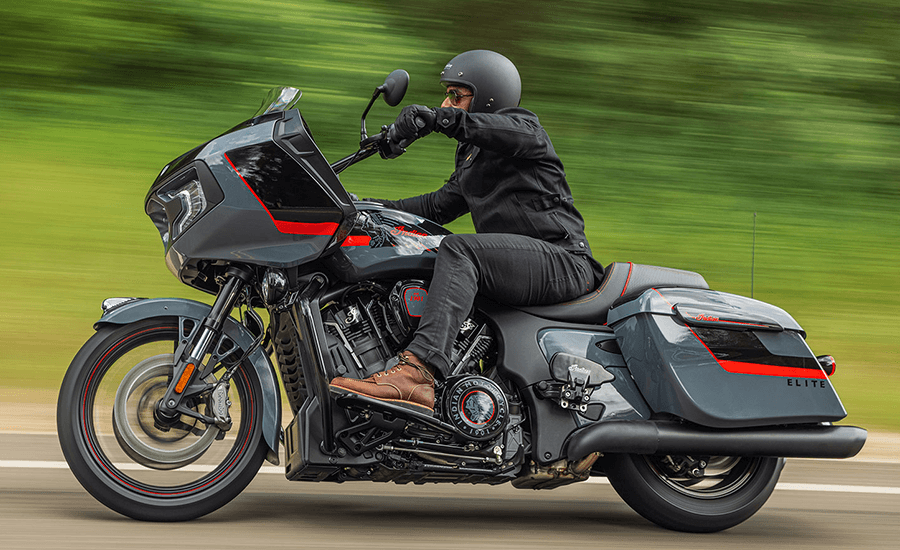
The Indian Challenger is a comfortable touring motorbike with a dip in the rider’s seat to provide back support for the rider. The low-mounted, pull-back handlebars are within comfortable reach of the rider. However, a shorter or average rider has to sit in a slightly forward riding position to reach the handlebars. The forward-mounted floorboards provide enough legroom for taller riders. The overall ergonomics are slightly uncomfortable for shorter and average riders. Riders who prefer laid-back riding ergonomics may want to replace the stock handlebars with mid-mounted, swept-back handlebars. The Indian Challenger can be transformed into an ideal touring motorcycle by installing a large windscreen, sissy bars, and backrests.
5.2 Comfort and Ergonomics: Harley Davidson Road Glide
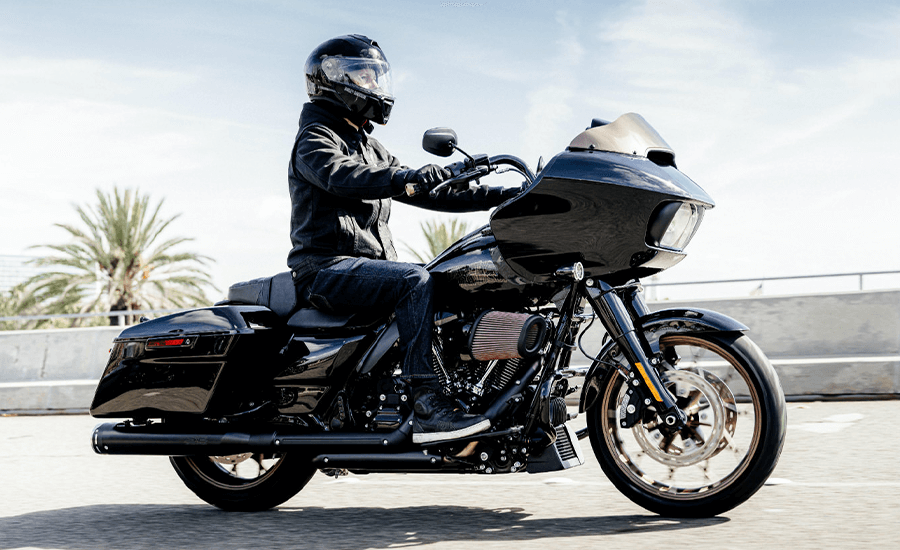
The Harley Davidson Road Glide’s mid-mounted, swept-back handlebars ensure a relaxed riding position. It also comes with forward-mounted floorboards so that the rider can rest their feet while cruising on highways. Adequate legroom, handlebar position, and a low seat height of 25.9 inches make this motorbike suitable for average and taller riders. However, the Harley Road Glide’s wet weight of 855 lbs makes it difficult to maneuver at low speeds. The stock fairing, saddlebags, crash bars, and comfortable ergonomics make it an ideal touring bike. However, to improve touring performance, the Harley Road Glide can be fitted with a large windscreen, sissy bars, luggage racks, and backrests.
6. Technology and Features: Indian Challenger Vs. Harley Davidson Road Glide
| 2022 Indian Challenger | 2022 Harley Davidson Road Glide | |
|---|---|---|
| Technology and Features | ||
| Standard | ABS | Optional |
| Standard, Rain, and Sport | Ride Modes | ✕ |
| ✕ | Electronic Linked Braking (ELB) | ✓ |
| ✓ | Cruise Control | ✓ |
| ✓ | Speedometer | ✓ |
| ✓ | Fuel Gauge | ✓ |
| ✓ | Low Oil Pressure Indicator | ✓ |
| ✓ | Clock | ✓ |
| ✓ | Odometer | ✓ |
| ✓ | Gear Display | ✓ |
| ✓ | Passenger seat | ✓ |
| Infotainment | ||
|---|---|---|
| Ride Command | System | Boom!™ Box 4.3 |
| Color | System Type | Color |
| Two | Speakers | Two |
| ✓ | Bluetooth | ✓ |
| ✓ | AM / FM | ✓ |
| ✓ | USB Connection | ✓ |
7. Pros and Cons: Indian Challenger Vs. Harley Davidson Road Glide
7.1 Pros and Cons: Indian Challenger
| Indian Challenger Pros | Indian Challenger Cons |
|---|---|
| Powerful engine | Heavyweight |
| Ideal touring motorbike | Unreliable navigation system |
| Liquid-cooled engine | Limited color scheme options |
| Produces more horsepower and torque | Uncomfortable stock seat |
| ABS and cruise control are standard | Fairing starts to rattle at high speeds |
| Comes with three riding modes and rear cylinder deactivation system | Small stock windscreen |
| High-performance front and rear suspensions | |
| Stock saddlebags, fairing, and floorboards | |
| Good cornering | |
| Aesthetically pleasing |
7.2 Pros and Cons: Harley Davidson Road Glide
| Harley Davidson Road Glide Pros | Harley Davidson Road Glide Cons |
|---|---|
| Comfortable touring bike | Difficult to ride through traffic |
| Stock frame-mounted fairing | Heavyweight |
| Mid-mounted, swept-back handlebars | Difficult to maneuver while turning corners |
| Relaxed riding position | Inadequate torque and horsepower |
| Standard cruise control | ABS is optional |
| Stock crash bars, saddlebags, and fairing | Small stock windscreen |
| Stock infotainment system |
8. Colors and Cost: Indian Challenger Vs. Harley Davidson Road Glide
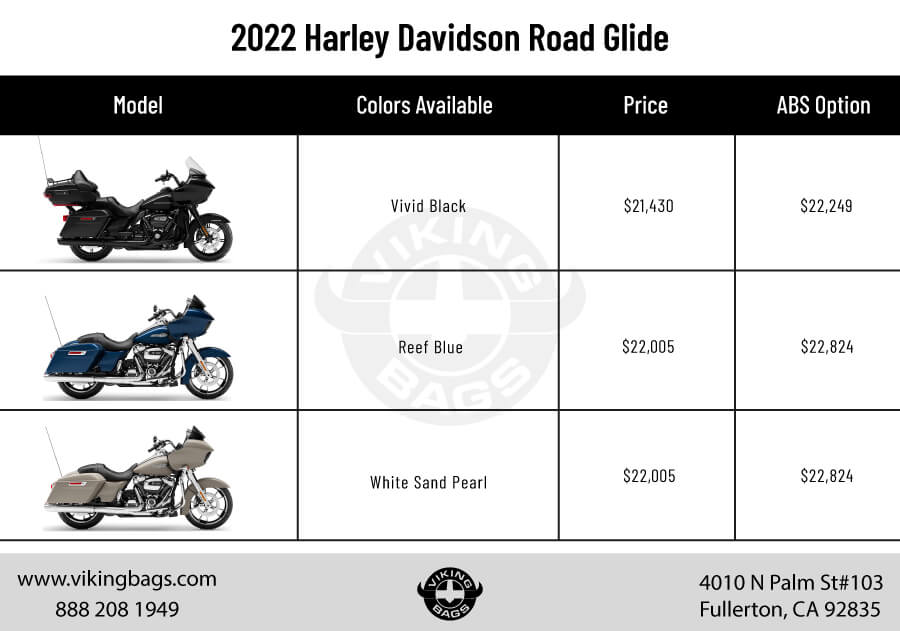
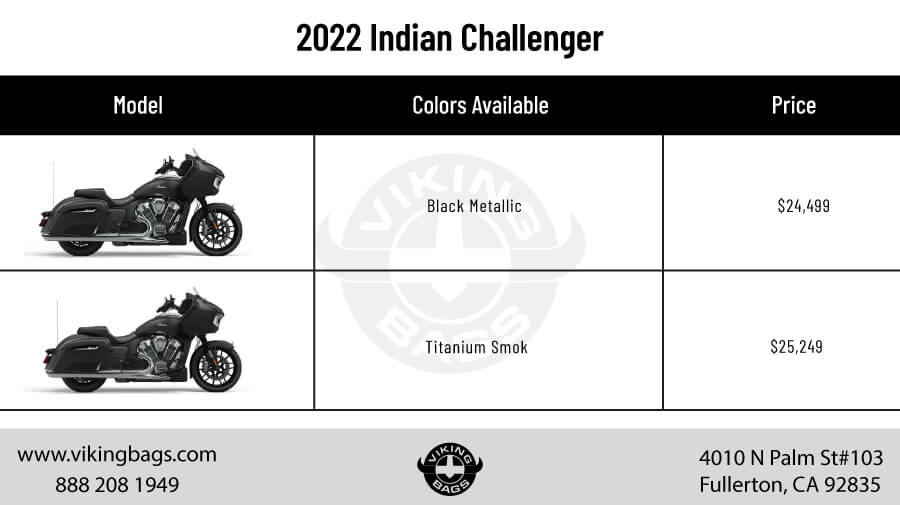
9. Frequently Asked Questions (FAQs)
9.1 Are Indian Motorbikes as Good as Harley Davidson Motorbikes?
Both Indian and Harley Davidson are popular motorcycle brands. Harley Davidson has been dominating the American market since the 1920s. Meanwhile, Indian has recently made a big name in the American cruiser market. Both motorcycle brands are reliable and produce high-performance motorbikes. However, Indian motorbikes have a slight edge when it comes to raw performance.
9.2 What are the Key Differences between the Indian Challenger and the Harley Davidson Road Glide?
| Key Differences: Indian Challenger Vs. Harley Davidson Road Glide | |
|---|---|
| Indian Challenger | Harley Davidson Road Glide |
| Comes with a radiator | Comes with stock crash bars |
| Liquid-cooled | Air-cooled |
| Produces more horsepower and torque | Produces less horsepower and torque |
| Blacked-out and chrome parts | Chrome parts |
| Slightly swept-back handlebars | Highly swept-back handlebars |
| ABS is standard | ABS is optional |
| Three riding modes (Rain, Standard, and Sport) | No riding modes |
| Smaller rake and trail size | Bigger rake and trail size |
| Seat height of 26.5 inches | Seat height of 25.9 inches |
| Wet weight of 831 lbs | Wet weight of 855 lbs |
| Length of 98.5 inches | Length of 95.7 inches |
10. Which Is Better: Indian Challenger Vs. Harley Davidson Road Glide
The Indian Challenger and the Harley Davidson Road Glide are popular American touring bikes. Both motorcycles have stock shark-nose fairing, hard saddlebags, and forward-mounted floorboards. They are designed to perform better across longer distances and cruising on highways. However, the Indian Challenger has several advantages over the Harley Road Glide, including a powerful engine, more horsepower and torque, better handling, and cornering capability. It comes with standard ABS, cruise control, an automatic rear-cylinder deactivation system, and three riding modes. The Indian Challenger is also lighter than the Harley Road Glide due to its lightweight aluminum frame. Meanwhile, the Harley Road Glide has comfortable riding ergonomics, has the classic Harley Davidson attitude, and is $3,069 cheaper than the Indian Challenger.













Leave a comment
All comments are moderated before being published.
This site is protected by hCaptcha and the hCaptcha Privacy Policy and Terms of Service apply.